John Arthur Thomson was born on 8 July 1861 in East Saltoun, Scotland. A Scottish naturalist, he sought to reconcile science and religion and was an expert on soft corals. After studying natural history at the University of Edinburgh, he became Fellow of the Royal Society of Edinburgh at age 25. His first teaching post was at the Royal Veterinary College beginning in 1893. He was Regius Professor of Natural History at the University of Aberdeen from 1899 until his retirement in 1930.
Knighted in 1930 by King George V, he lectured at Union Theological Seminary and Yale. His book, Outline of Science, published in 1922, sold more than one hundred thousand copies. Other notable works include Parasitism: Organic and Social (1895), Progress of Science in the Century (1903), Heredity (1908), Darwinism and Human Life (1909), Evolution, with Patrick Geddes (1912), Zoological Studies (1911–1915), What is Man? (1923), Science and Religion (1925), Modern Science (1929), Life: Outlines of General Biology (1931), Riddles of Science (1932), and the posthumously published Biology for Everyman (1933).
